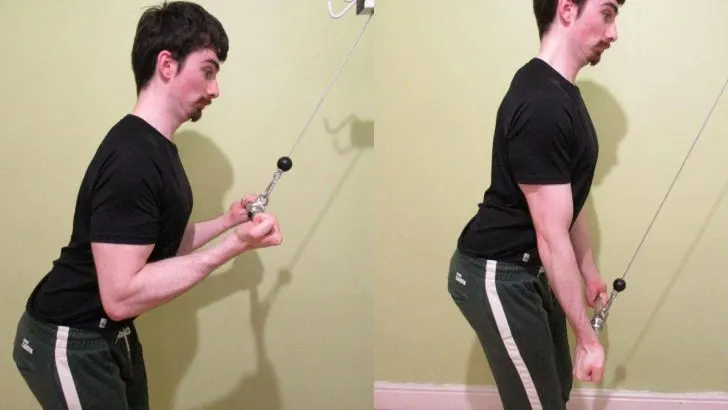The reverse grip tricep pushdown is an intense and highly effective exercise for developing all three heads of the triceps.
This is because the supinated grip used during underhand pushdowns encourages you to keep your elbows pinned to your sides, which in turn produces a stronger tricep peak contraction.
Although you can push heavier poundages during an overhand straight bar cable extension, this extra resistance doesn’t necessarily translate into more muscle growth because, as simple pieces of meat, your triceps don’t know what “weight” is. They just respond to tension.
This tutorial shows you how to do a reverse grip cable extension with the optimal tricep-building form. After that, we’ll explore the benefits of the exercise as well as the technique mistakes that could be holding back your reverse pushdown progress.
Related: Close grip straight bar pushdowns
Reverse grip tricep pushdown exercise details
- Also Known As: Underhand tricep pushdown, supinated pushdown
- Main Muscles: Triceps
- Exercise Type: Strength
- Exercise Mechanics: Isolation
- Difficulty Level: Beginner
- Equipment Needed: Bar attachment, cable machine
How to do reverse grip tricep pushdowns
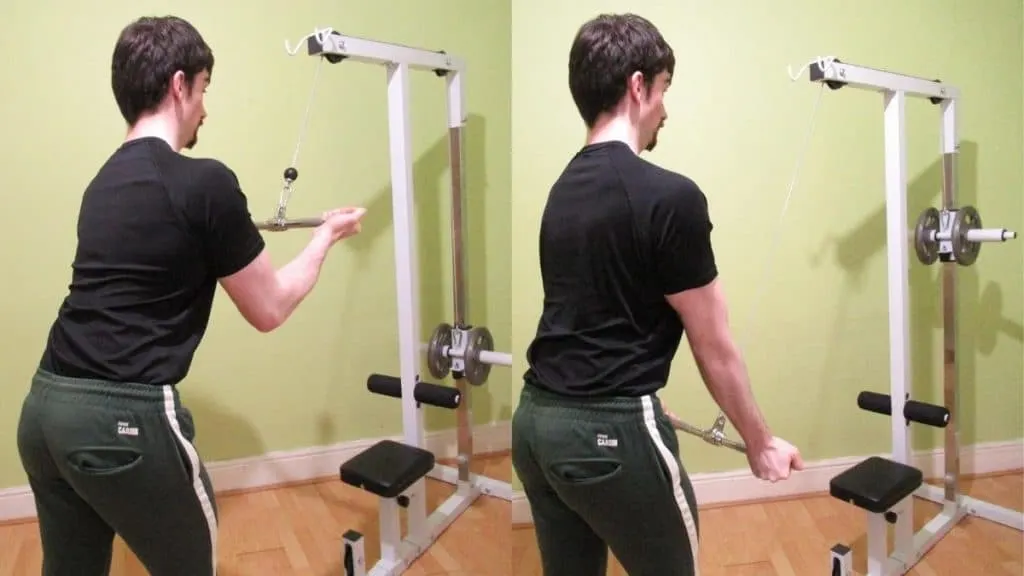
- Connect a bar attachment to a high pulley.
- Grab the bar with a firm, underhand grip and then step away from the machine.
- Bend over slightly (while keeping your spine straight) and brace your core.
- While keeping your elbows pinned to your sides, flex your triceps to push the bar down.
- Keep pushing until your elbows reach complete extension.
- Squeeze your triceps forcefully at the bottom of the rep.
- Release the contraction in a controlled manner (don’t let your elbows drift forward).
- Raise the bar until it gets to around chest height, then perform your next rep.
- Perform 3-5 sets of 10-20 reps in total.
Reverse grip tricep extension benefits
Many people perform reverse grip tricep pushdowns without fully understanding the benefits that they can gain—with enough effort and consistency—from the exercise.
In addition to highlighting general pushdown benefits, this article explains how the reverse tricep pushdown is potentially much more effective than the overhand version of the exercise—especially over the long term.
Complete triceps isolation
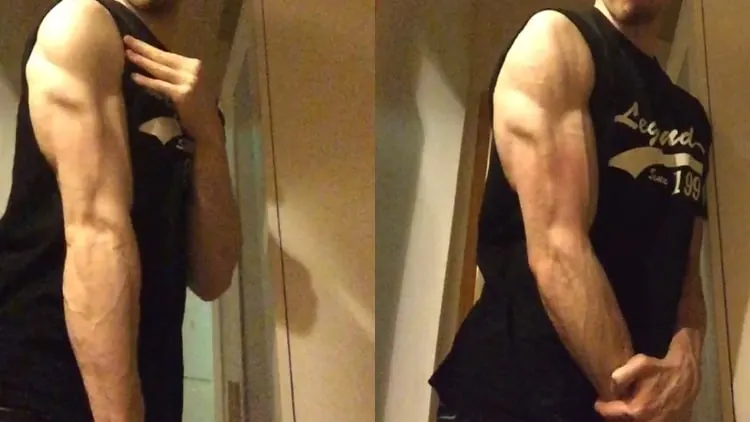
Any pushdown that’s performed with the proper form provides complete triceps isolation.
This is simply because pushdown is another way of saying elbow extension.
Elbow extension is the primary function of the triceps because the triceps is the only muscle group that’s capable of straightening the arm.
Yet, because the long head of the triceps (the largest triceps muscle) also acts on the shoulder joint, many lifters move away from pushdowns and perform overhead extensions instead.
While performing skull crushers and overhead movements certainly trains the long head well—optimally, in fact—the lateral and medial heads need plenty of work as well if you want to achieve complete triceps development.
The reverse grip tricep extension is an excellent exercise in this regard because when your arms are by your sides, the long head can’t dominate the movement at the expense of the lateral and medial heads. This is because your shoulders are in a neutral position during a reverse tricep extension, which means that the long head can’t perform its second function, namely, shoulder extension.
So while overhead extensions are undeniably prolific when it comes to building triceps size, reverse cable pushdowns are king when it comes to training the other two tricep muscles.
Intensified triceps contraction
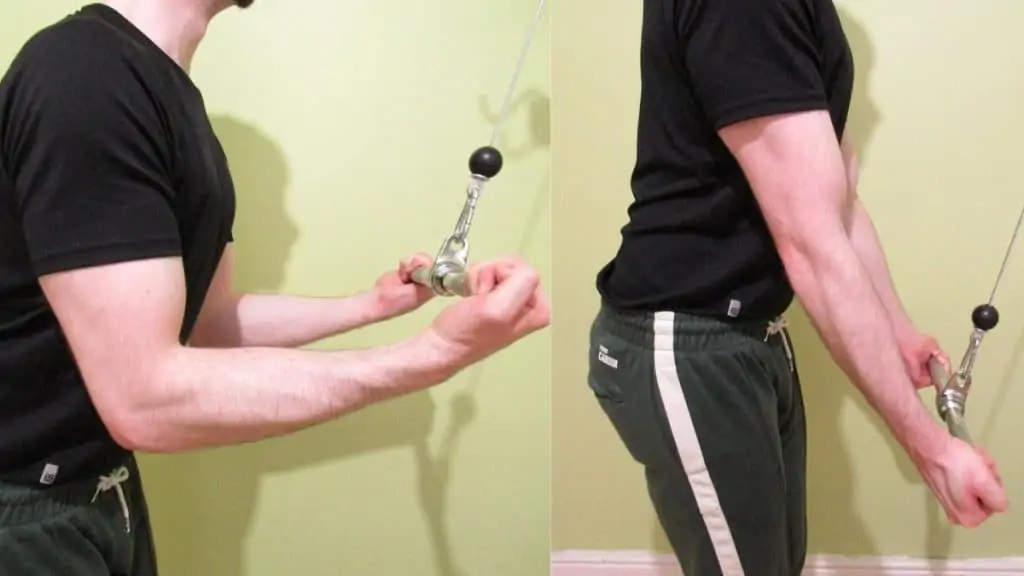
During exercises like incline bench pressdowns, your arms are way out in front of your body. This flexed shoulder positioning naturally produces a deep triceps stretch (the more flexed that your shoulders are, the more that the long head gets stretched), but it doesn’t offer much in the way of a peak contraction.
However, during the reverse cable pushdown and rocking triceps pushdowns, your elbows are much tighter to your sides, and your shoulders aren’t flexed at all.
If anything, your shoulders are actually in slight extension at the bottom of a reverse pushdown rep, which is the main reason why you’ll feel an intensified peak contraction during an underhand tricep pulldown.
This enhanced peak contraction can also improve your mind-muscle connection because it gets you accustomed to flexing your triceps forcefully under load.
A better mind-muscle connection helps you to get more out of every reverse press down rep, which is to say that your sets will produce a stronger hypertrophic stimulus when you challenge your triceps with more tension thanks to your improved mind-muscle connection.
Reduced wrist discomfort

The cable underhand tricep extension is more comfortable to perform than traditional bar pushdowns because it doesn’t force your wrists into pronation.
In fact, your wrists aren’t in pronation all—they’re completely supinated.
Because of this supinated grip, many people commonly refer to the exercise as a reverse tricep pulldown because you’re effectively pulling the bar down with your triceps rather than pushing directly into it with your hands.
This triceps-first lifting motion takes the pressure off your wrists and enables you to increase the resistance without worrying if your joints can handle the strain, an attribute that makes underhand pushdowns ideal for maximizing your long-term triceps development.
The EZ bar pressdown, which you can also perform with an underhand grip, is another good option because EZ bars have semi-pronated grips, which means that your wrists are never forced into full pronation.
Greater compound pressing power
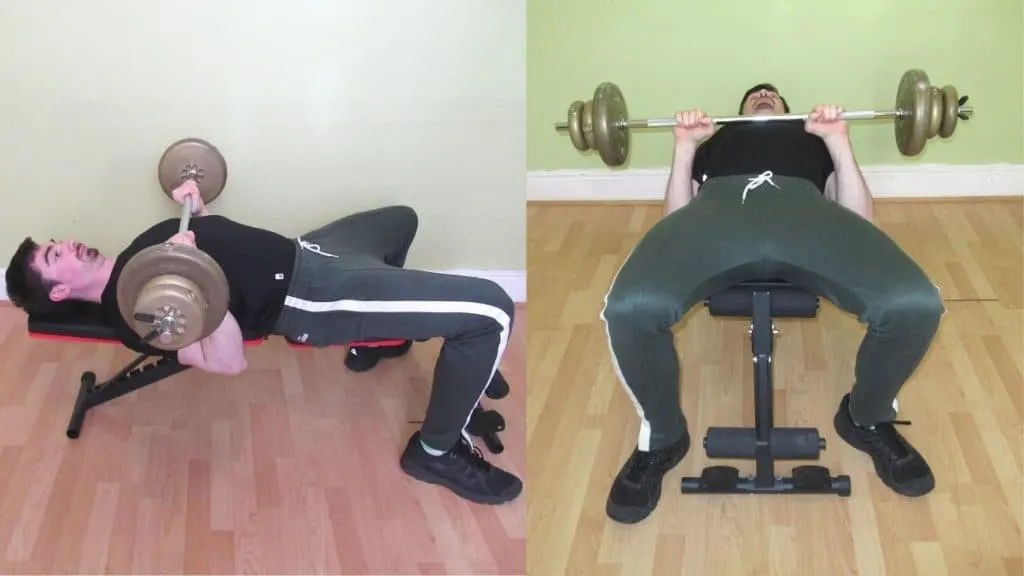
Many gym-goers don’t realizer this, but the reverse tricep extension is strikingly similar to the final part of a bench press or overhead press rep.
During any kind of compound press, the last part of the repetition is handled primarily by the triceps because only the triceps can lock the elbows out.
Well, elbow lockout out is another way of referring to a pushdown.
At the elbow joint, the action performed in a bench press and in a pushdown is identical.
As such, if you want to improve your lockout strength and boost your pressing power, then it pays to also increase your reverse grip push down strength because it’ll get your triceps used to locking out heavy loads.
Pressdowns will, of course, improve your pressing power regardless of whether you do a tricep pushdown with a rope or bar.
More workout variety
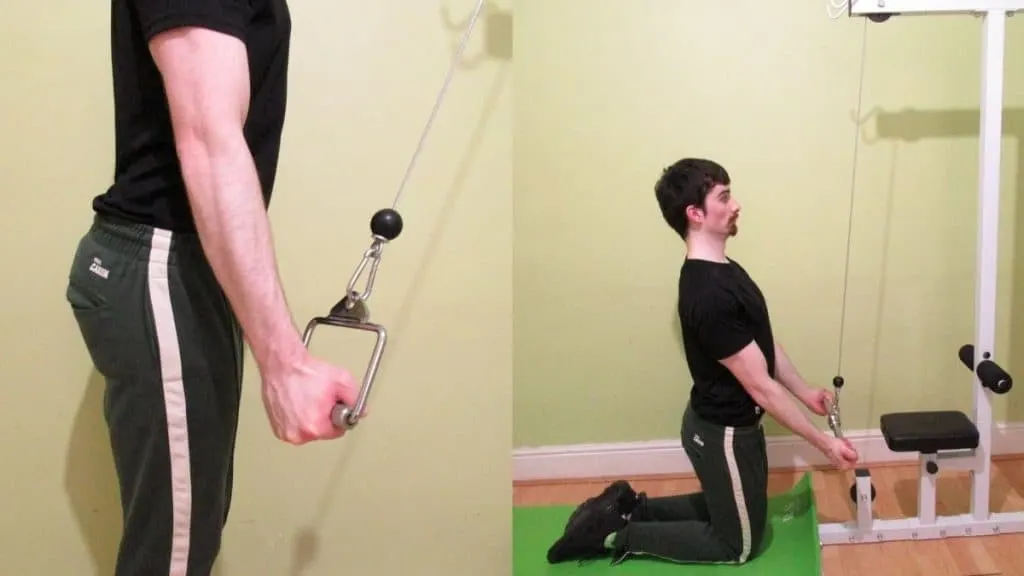
There are so many reverse grip cable pushdown variations that you can do.
If you want to improve your triceps symmetry, then the one arm reverse pushdown is your best bet. While you’ll need to lift less weight when training unilaterally, the single arm reverse pushdown is the top choice for avoiding (or reducing existing) tricep size asymmetries.
If you want to enhance your triceps mind-muscle connection and muscular endurance, then the reverse iso pushdown is the way to go.
If you want to challenge your core muscles while training your triceps, then you can get some extra ab work in with reverse Swiss ball tricep pushdowns. In this regard, the kneeling rope pressdown, which you can also do with a bar, is another effective exercise for stimulating your abs as well as your triceps.
And, if you’re training at home, you can do a reverse resistance band tricep pushdown by anchoring your band to the top of your doorframe or a doorway pull-up bar.
With all of these exercise possibilities at your disposal, you’re bound to find a reverse grip pushdown variation that aligns with your training goals and makes you excited to work out.
Reverse grip cable extension mistakes
Make sure to avoid these 3 mistakes if you want to get the most out of the reverse grip cable tricep extension.
Incorrect elbow placement
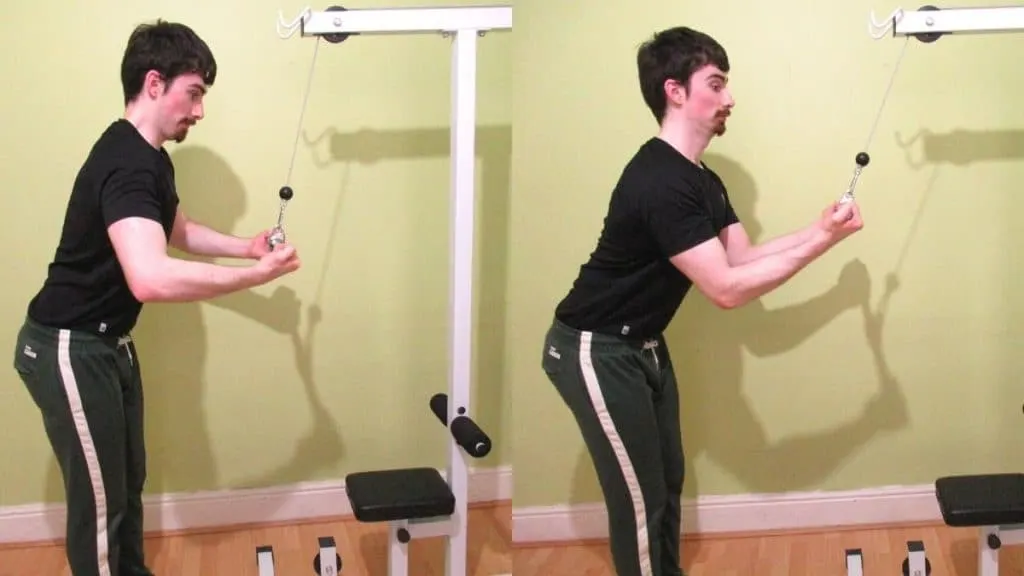
There are two ways that your elbow positioning can ruin your reverse grip cable pressdown workout.
Your elbows can either be too far forward, in which case your lats will take over the movement, or they can be too flared out, in which case your tricep pushdown turns into a compound press.
Let’s tackle the first issue. Letting your elbows drift too far forward may well activate the long head of the triceps more (when your elbows drift forward, your shoulders move into flexion, which stretches the long head).
However, there’s no need to maximally train the long head during every exercise that you perform. As noted previously, the lateral and medial heads need plenty of work as well if you want to sculpt aesthetic triceps.
Additionally, the lats are an even more powerful shoulder extensor than the long head of the triceps. So while you may still feel your triceps working when you let your elbows come forward, the lateral and medial heads won’t be getting much stimulation at all because they only act on the elbow joint.
As for letting your elbows flare out, this mistake is the most obvious sign that the weight you’re lifting is simply too heavy. Excessive elbow flare also causes your chest and shoulders to become activated at the expense of your triceps. So make sure to avoid leaning into the movement if you want to isolate your triceps.
Using momentum
Momentum is the enemy of muscle growth.
Far too many lifters let the bar shoot up during reverse grip extensions after releasing the contraction.
Why go through all that effort of lifting the weight to then rob your triceps of tension during the most crucial phase of the rep, the eccentric?
It doesn’t make any sense.
Letting the bar shoot up causes the weight stack to slam, it hurts your elbows, and it takes tension off your triceps. In other words, it’s the worst reverse grip tricep extension mistake that you can make.
Instead, release the contraction in a controlled manner over a 3-5 second period. Raise the bar to around chest height without letting your elbows drift too far forward (the closer you can keep your elbows pinned to your sides, the better).
You know that you’ve gone far enough when the undersides of your forearms push right up against your biceps. In fact, you can actually flex your biceps to ensure that you’re getting a full range of motion (when the biceps are contracted, the triceps are, by definition, lengthened and stretched).
Performing partial reps
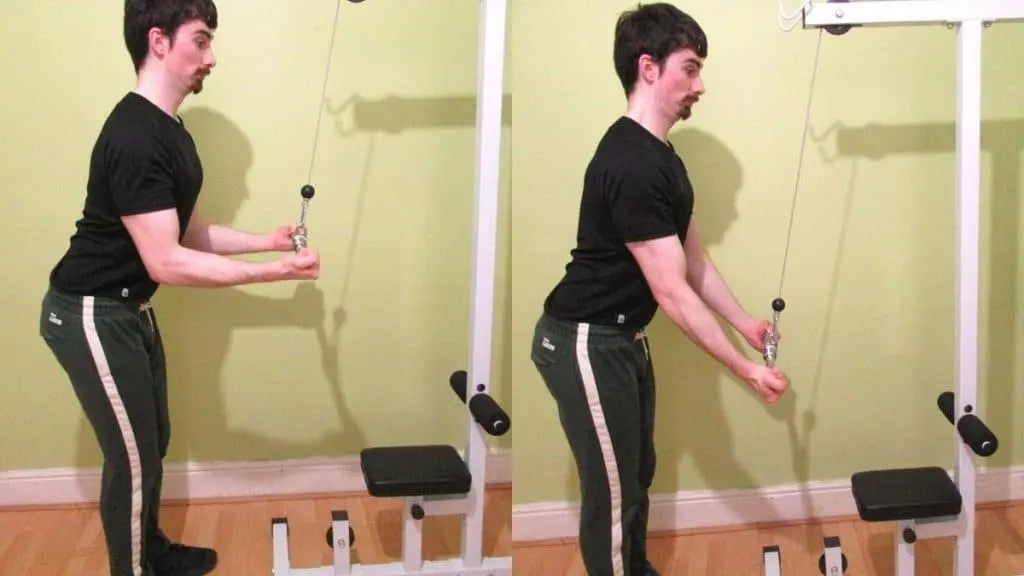
Partial-rep reverse pushdowns can certainly build muscle (and they’re highly effective for burning out your triceps at the end of the session after you reach failure on full-rep reverse pushdowns).
However, as intense as they may feel, half rep reverse grip tricep pushdowns simply aren’t optimal for developing your triceps.
Instead of stopping short of lockout, make sure that you achieve complete elbow extension on every single rep. After all, elbow extension is the main function of the triceps. So by skipping the lockout phase of the rep, you’re denying the reality of anatomy and missing out on muscle growth as a result.
And besides, the peak contraction is what converts people to reverse grip tricep extensions in the first place. So why skip the most enjoyable part of the rep?
The contraction is more intense when you use a supinated grip because a) your elbows are pinned to your sides and b) your shoulders are in line with your torso rather than in front of it.
Reverse tricep pushdown sets, reps, and training advice
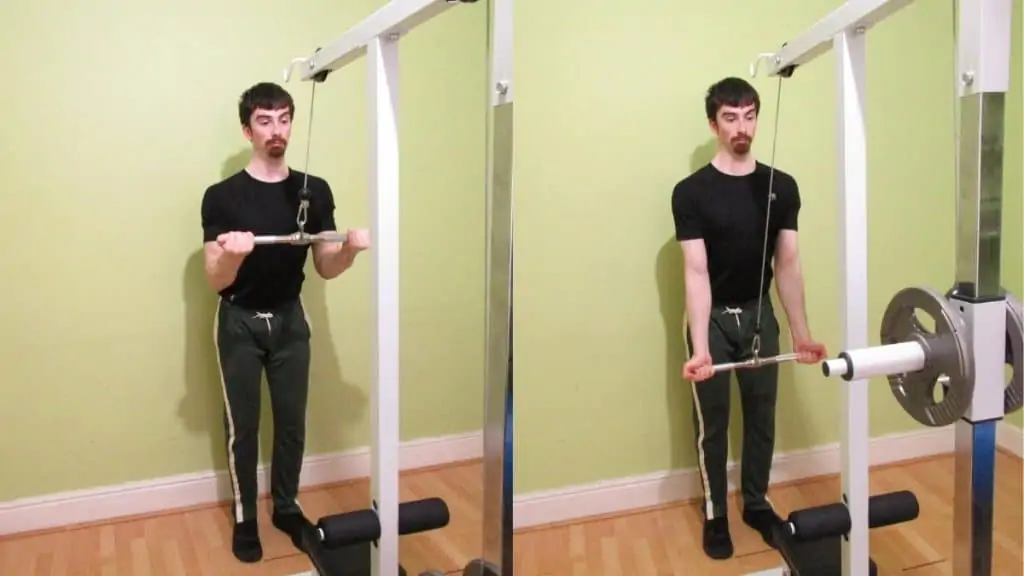
Perform the reverse grip triceps pushdown 1-3 times per week and do 3-5 sets of 10-20 reps per session.
This is a general recommendation that will cover most people’s bases.
The optimal training frequency and volume—and the ideal number of reps and sets— however, depends on your goals, training experience, and recovery capabilities.
If you want to maximize your triceps development over the short and mid-term, then it makes sense to do the supinated tricep extension two times per week rather than just once a week.
This is because research shows that higher training frequencies, up to a point, tend to result in more muscle growth due to a) allowing you to perform higher quality training volume and b) providing regular muscle protein synthesis spikes.
Similarly, the better that your recovery capacity is, the more reverse push down training volume your triceps can withstand. Therefore, if you’re in the middle of a cutting phase or struggling to get enough sleep, then it’s a wise idea to scale back your volume so that you can avoid overtraining.
As for reps, the tricep reverse pushdown is best suited to higher repetitions (10-20) because it’s a single joint exercise, meaning that it relies on strict form in order to train the target muscles effectively.
It’s not that you can’t do the underhand cable pushdown for low reps; it’s just that you’re better off saving your low rep training for your compound presses and free weight tricep extensions.
Underhand vs overhand tricep pushdown
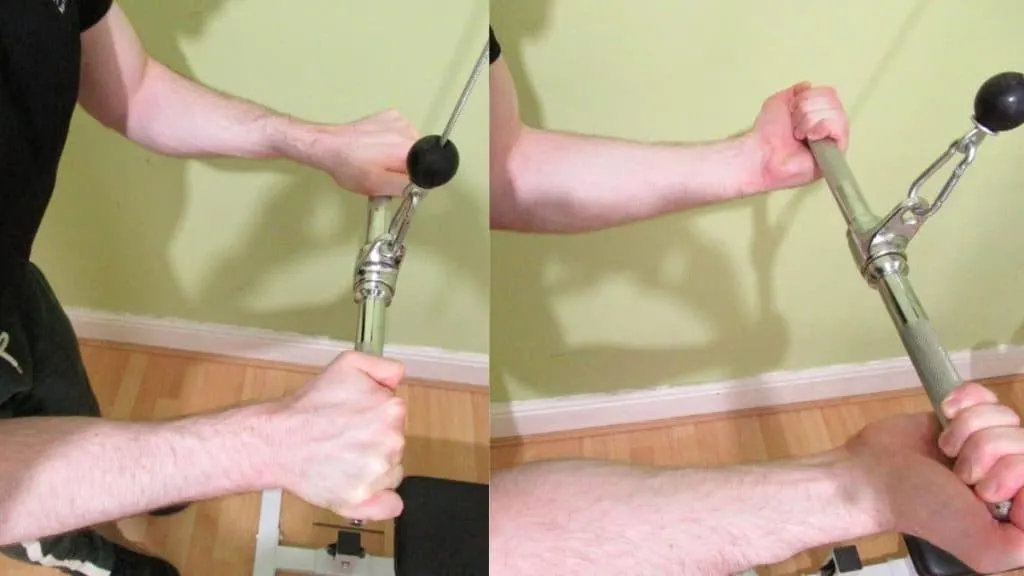
What is the difference between underhand pushdowns and overhand pushdowns?
And, more importantly, which grip is the best for working your triceps?
The underhand tricep pushdown produces a stronger peak contraction than the overhand variation. This is because when you use a reverse grip, your shoulders become externally rotated, which encourages your elbows to move inward and closer to your sides.
While it’s true that you can rotate your wrists without moving your elbows an inch, that’s not how things work in the gym. In practical strength training scenarios, turning your wrists almost always leads to movement at the shoulder joint (and thereby the elbow).
The reason that keeping your elbows close to your sides results in an intensified peak contraction is that pinning your elbows to your sides tends to put your shoulders into slight extension. This extended shoulder positioning enables the long (inner) head of the triceps to contract with more force because it’s in a shorter anatomical position (when your shoulders are extended).
In terms of strength, you’ll naturally be able to lift more weight during regular pushdowns than during reverse grip pushdowns. This is because when you use an overhand grip, you’re able to generate more force by pushing into the bar with the palms of your hands.
When you do a reverse grip cable pushdown, on the other hand, you essentially have to pull the bar down with your triceps, which means that you can’t grip the bar with the same firmness.
The third and final difference between reverse grip tricep pushdowns and regular pushdowns is that using a reverse grip typically puts less pressure on your joints because it doesn’t force your hands into pronation.
Read More: Wide grip cable press down
Conclusion: Who should do a reverse grip tricep pressdown?
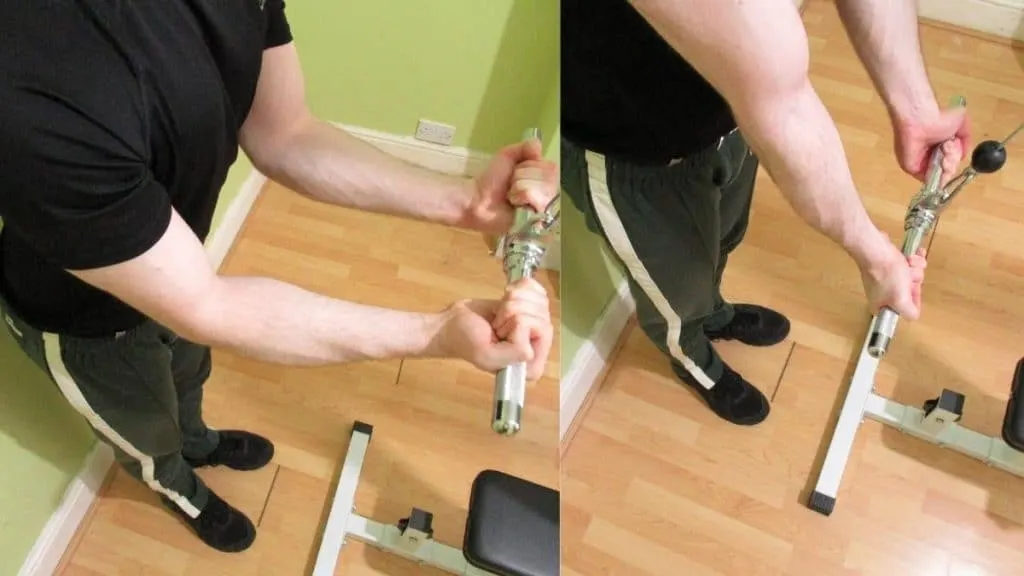
If you want to challenge your triceps while keeping your wrists in a joint-friendly supinated position, then the reverse grip tricep pushdown is definitely worth including in your workout routine.
The reverse grip cable extension encourages you to keep your elbows close to your sides, which in turn helps you to maintain the proper muscle-building form, something that results in an intensified peak contraction.
It’s best to perform the standing reverse triceps extension toward the end of your workout because you’ll be utilizing higher repetitions.
This high-rep training style enables you to end your session with an intense triceps pump and plenty of volume. In other words, high-rep underhand tricep extensions—performed in conjunction with heavier exercises earlier on in the workout—are a recipe for muscle growth.

